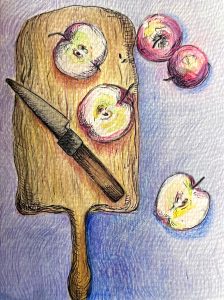A summer’s field work: investigating vegetation and climate change in the Pacific Northwest across a global warming episode in Earth’s past
By Alex 2.LoweEverything we observe, measure, and find beautiful in today’s world is just one example of how our planet’s systems can be arranged, meaning our biosphere, atmosphere, hydrosphere, and lithosphere. Looking into our planet’s history provides numerous examples of other possible arrangements and relationships between these systems. Looking forward, our world will change. How do we know what it will look like if all we’ve done is focused on our one example—the modern?This summer’s field work brought my undergraduate field assistant, Sophie, and me to Idaho in search of context to the aforementioned issue. This work is part of a collaborative project recently funded by The National Science Foundation to understand how plant communities and regional climates in the Pacific Northwest responded to a global warming event in Earth’s past, the Middle Miocene Climatic Optimum (MMCO). The event occurred ~17 to 15 million years ago, with the main driver of climatic change still debated. Fortunately, the Pacific Northwest has a fantastic record of fossil plant localities that represent before, during, and after the MMCO.
Sophie and I worked at Clarkia (Cla), Juliaetta (Jul), Succor Creek (SuC), and Pickett Creek (PC) in Idaho. The first step was to collect volcanic ash from each site to obtain radiometrically dates (U-Pb) so we know exactly when the plants we sample were living. We are collaborating with Dr. Mark Schmitz at Boise State University, who uses cutting edge and high precision methods that can produce ±20,000 year age resolution (which is great). Next step was to measure and describe all of the rock layers through the exposed vertical sequence, so we can interpret the type of environment the plants were living in. Our final step was to collect fossil plants! Our study is novel because we are combining three fossil plant types from each site, and each type provides their own unique perspective on what the vegetation looked like: macrofossils (macroscopic organs like leaves), pollen, and phytoliths (microscopic silica bodies deposited in plant tissues). Many studies only consider one, and comparisons drawn between studies utilizing different fossil plant types are difficult to make.
| Examples of fossil plant types. A. Birch leaf (Cla) B. Avacado-like leaf (Spo) C. Birch stomata (Cla) D. Sweet gum pollen (MoM) E. Grass phytolith (Cla) F. Epidermal phytolith (Spo) |
The trip was very successful, and we had a blast road tripping around Idaho! The Clarkia fossil site of northern Idaho, where we stayed for three weeks is of particular note. This is a world class site with incredible preservation of leaves, fruits, cones, and flowers. The site is a stone’s throw from Dr. Bill Rember’s (U. of Idaho) house, who is a collaborator on our project, and it has been his life’s work. The preservation is so good that Bill has created a method to float the leaf off the rock and store it as a biological specimen, rather than a geologic one. A really cool video of the site and this process can be seen in this Plants are cool, Too! video
https://www.youtube.com/watch?v=YfRXDbtkEi0
Now with our fossils back at the Burke Museum, we will extract and isolate pollen and phytoliths and count and characterize the plant types that they represent. We will organize macrofossils into species and “species-like” groups (i.e., morphotypes) and characterize the relative abundance, diversity, and functional traits of the different floras. In summers to come we will continue ticking off the many other study sites shown in the map above.
 |
| Sophie and me on a side trip to south-central Wyoming to collect fossil plants, included only because it’s the only picture of us together! |
I did note that a goal of the project was to characterize regional climate change in the Pacific Northwest across this global warming event. We will use both the taxonomic composition of our fossil floras, as well as the shapes, sizes, and “toothiness” of fossil leaves, to reconstruct temperature and precipitation related climatic variables. We will also reconstruct atmospheric pCO2 by looking at the density of pores (stomata) in the fossil leaves. Because global climate change can manifest very differently in different regions, it’s important to document how exactly regional climates in the Pacific Northwest changed during the MMCO. We will address this by comparing climate and pCO2 estimates from different sites through time.
In summary, as results start to come together over the next few years, we will piece together an example of how plants and regional climates change during a global warming episode (fingers crossed). While there are obvious and important differences between today and 17 million years ago, there are also many similarities. The continents were in similar positions, the floras were quite modern, and fundamentals of plant physiology that influence plant ecology were the same. This example, in combination with other examples from past studies and those to come, will highlight possible arrangements and relationships of our planet’s systems that we may expect to arise in the future.
Alex is a 2nd year PhD student in Caroline Stromberg’s lab


